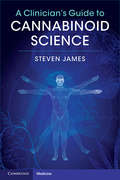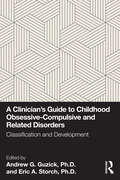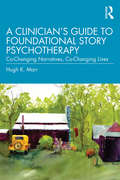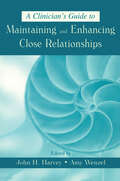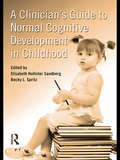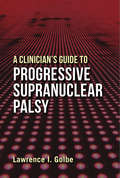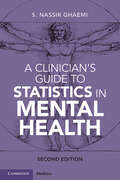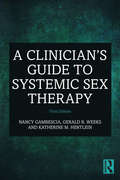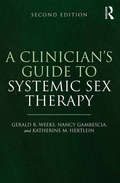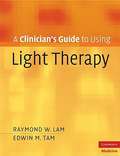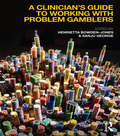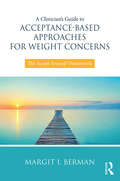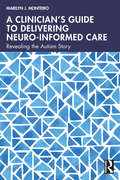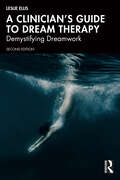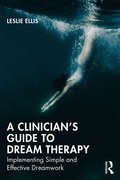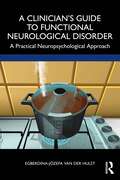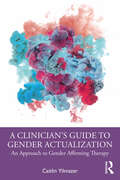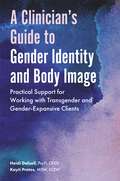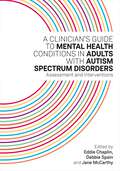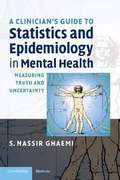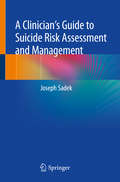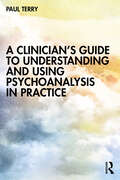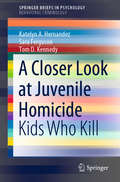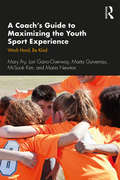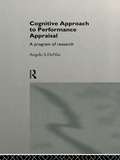- Table View
- List View
A Clinician's Guide to Cannabinoid Science
by Steven JamesMedical marijuana and the promise of medical advances with cannabinoids is a controversial topic. This book provides clinicians with credible, peer-reviewed science to advise patients on the use of cannabinoids in practice. From the history of cannabis to the recent discoveries, chapters include the science of cannabinoids, changes in the legal and regulatory landscape, and the emerging area of endocannabinoids. The book differentiates approved cannabinoids from cannabis and medical marijuana and stimulates clinicians to think about the risks and benefits of these two drugs. It provides the factual background for clinicians to lead the discussion on the continued use of marijuana, ongoing areas of research and future advances and development of new medications for treatment. An invaluable guide for all specialists in the pharmaceutical sciences, toxicologists, biochemists, neurologists, psychiatrists, addiction specialists, as well as primary care physicians, nurse practitioners, and regulators and policymakers.
A Clinician's Guide to Childhood Obsessive-Compulsive and Related Disorders: Classification and Development
by Andrew G. GuzickThis book provides mental health clinicians and trainees with an overview of the new category of obsessive-compulsive and related disorders as they apply to youth.These disorders are highly impairing but can typically be overlooked in children and adolescents when they most often onset. This book draws attention to these disorders and provides an up-to-date review on the classification and development of these conditions in youth. Chapters explore the arguments for and against the new obsessive-compulsive related disorder DSM-5 category, provide reviews of transdiagnostic factors believed to underly these disorders, as well expert overviews of the clinical disorders that make up this category. An international team of contributors focuses on a range of topics such as: pediatric acute-onset neuropsychiatric syndrome, early-onset and tic-related OCD, common comorbid psychiatric conditions in youth, developmental neurobiology, and more.This book is an essential read for clinicians who specialize in OCD and related disorders and treat children. It is also applicable to clinicians, trainees, and students across mental health disciplines such as: psychology, psychiatry, social work, mental health, and counselling.
A Clinician's Guide to Foundational Story Psychotherapy: Co-Changing Narratives, Co-Changing Lives
by Hugh K. MarrA Clinician's Guide to Foundational Story Psychotherapy draws together a range of theories and models to examine the use of narrative psychotherapy in clinical practice. Illustrated with case examples and biographical vignettes, the book outlines the importance of foundational and life stories in treatment and delineates new techniques for co-assessing and changing stories. A wealth of concrete tools are included, such as the Foundational Story Interview and Family of Origin Map, as well as diagram templates and questionnaires for use during clinical sessions. Integrating theory and practical applications, A Clinician's Guide to Foundational Story Psychotherapy introduces a range of therapeutic options rooted in a narrative context and is a valuable resource for practicing and student psychotherapists.
A Clinician's Guide to Maintaining and Enhancing Close Relationships
by Amy Wenzel John H. HarveyIn the past 10 years, there has been a substantial increase in the number of theoretical and empirical investigations into the maintenance and enhancement of close, romantic relationships. This literature targets the everyday behaviors, expressions of love, and cognitive styles that characterize such relationships. Chapters provide a sampling of the expanse of topics in the domain of how clinical scholars and practitioners address the timely topic of maintaining and enhancing close romantic relationships, including marriage. A distinguished group of scholars and therapists discuss specific problems, such as alcoholism and therapeutic interventions, such as insight therapy. Topics include maintenance issues relevant to: depression, anxiety disorders, the role of children in affecting close relationships, how premarital therapy may serve as an antidote to early relationship problems, forgiveness, remarriage issues, and peer marriage. This volume is intended for practitioners in the field of close romantic relationships, such as marriage, family and relationship therapists, and clinicians.
A Clinician's Guide to Normal Cognitive Development in Childhood
by Elisabeth Hollister SandbergClinicians and practitioners-in-training can often lose sight of the normal developmental landscape that underlies behavior, especially in the field of cognitive development. It exists in an insular bubble within the broader field of psychology, and within each sub-domain there is a wide continuum between the anchors of atypical and optimal development. Clinicians need to learn, and to be reminded of, the unique peculiarities of developing cognitive skills in order to appreciate normal developmental phenomena. In A Clinician's Guide to Normal Cognitive Development in Childhood, every chapter provides students and established professionals with an accessible set of descriptions of normal childhood cognition, accompanied by suggestions for how to think about normal development in a clinical context. Each sub-topic within cognitive development is explicated through a succinct presentation of empirical data in that area, followed by a discussion of the ethical implications. With an extensive review of data and clinical practice techniques, professionals and students alike will benefit enormously from this resource.
A Clinician's Guide to Progressive Supranuclear Palsy
by Lawrence I. GolbeThis brief, clinically-focused volume is informed by Lawrence I. Golbe’s three decades of research and tertiary clinical care in progressive supranuclear palsy, a complex disorder with rapidly changing diagnostic and therapeutic approaches. It is an ideal source for the general neurologist seeking a refresher and the primary care provider, neurological nurse, or physical, occupational or speech therapist who must address their patients’ specialized needs. A Clinician’s Guide to Progressive Supranuclear Palsy emphasizes early diagnostic signs, medication options, non-pharmacologic management and palliative care. It offers a quick overview of the complications of PSP most likely to prompt an ER visit; a widening spectrum of PSP variants; and ample description of the genetics, epidemiology, natural history, pathology, molecular biology and neurochemistry of PSP. The PSP Rating Scale used in the book is a convenient tool for clinicians in routine practice and the leading PSP clinical measure world-wide. Golbe provides a practical and useful guidebook to help all clinicians learn and battle this complex disorder.
A Clinician's Guide to Statistics in Mental Health: Measuring Truth And Uncertainty
by S. Nassir GhaemiThe second edition of a clear and accessible guide to the application of statistics in psychiatric practice. The book expertly describes statistical concepts in clear and simple terms, with minimal mathematical content, making it the ideal resource for busy mental health professionals. Fully revised throughout, it features five new chapters covering key advances in the field and important topics in greater detail. Amongst the key concepts discussed in this edition are the logic of randomization, clinical trials, the overuse of p-values, understanding effect sizes, meta-analysis and why clinical experience is limited by observational confounding bias. Featuring a wealth of clinical examples, on topics of high importance or controversy in psychiatry, plus explanations and reasoning, to give clinicians a better understanding of how to apply research to their practice.
A Clinician's Guide to Systemic Sex Therapy
by Gerald R. Weeks Nancy Gambescia Katherine M. HertleinThis new edition of A Clinician's Guide to Systemic Sex Therapy integrates the latest empirical research from the field of sex therapy and demonstrates how clinicians can optimize their treatment for a wide range of clients. Grounded in the Intersystem Approach, the book incorporates the multifaceted perspectives of the individual client, couple, or family. It considers every domain of assessment and treatment: biology, psychology, the intimate relationship, family-of-origin, and larger contextual factors contributing to any sexual/relational issue. This revised edition contains 13 chapters consistent with the DSM-5 definitions of sexual disorders and features new content on areas including LGBTQ+ issues, non-monogamous relationships, intersex clients, and an increased focus on issues surrounding sexual diversity. The authors of this award-winning text have set out a cutting-edge framework for clinicians looking to develop a comprehensive understanding of sexual issues, which will be an essential reference point for beginning and seasoned therapists alike.
A Clinician's Guide to Systemic Sex Therapy
by Gerald Weeks Nancy Gambescia Katherine HertleinThe second edition of A Clinician’s Guide to Systemic Sex Therapy has been completely revised, updated, and expanded. This volume is written for beginning psychotherapy practitioners in order to guide them through the complexities of sex therapy and help them to be more efficient in their treatment. The authors offer a unique theoretical approach to understanding and treating sexual problems from a systemic perspective, incorporating the multifaceted perspectives of the individual client, the couple, the family, and the other contextual factors. Both beginning and experienced sex/relationship therapists will broaden their perspectives with the Intersystem approach and gain information rarely seen in sex therapy texts such as: how to thoroughly assess each sexual disorder, the implementation of various treatment principles and techniques, how to incorporate homework, dealing with ethical dilemmas, understanding different expressions of sexual behavior, and addressing the impact of medical problems on sexuality. Aside from bringing the diagnostic criteria up-to-date with the DSM 5, this new edition contains a new chapter on sensate focus, an expanded section on assessment, more information about development across the lifespan, and more focus on diversity issues throughout the text.
A Clinician's Guide to Using Light Therapy
by Raymond W. Lam Edwin M. TamLight therapy is an effective, evidence-based, non-pharmacological treatment for seasonal affective disorder (SAD) and other depressive and circadian sleep conditions. This step-by-step guide helps busy mental health clinicians and other health professionals to better diagnose SAD and incorporate light therapy into their everyday clinical practice. The authors summarize the diagnostic process, describe a simplified method for light therapy and provide practical information on how to evaluate and obtain light devices. Invaluable clinician resources such as educational handouts, lists of frequently asked questions, instruction sheets, rating scales and suggestions for additional sources of information are also included. Case studies are used throughout to illustrate the processes and techniques in their clinical context.
A Clinician's Guide to Working with Problem Gamblers
by Henrietta Bowden-Jones Sanju GeorgeProblem gambling is a recognised mental disorder and a significant public health issue internationally. A Clinician’s Guide to Working with Problem Gamblers introduces the reader to the concept of problem gambling as an illness, it describes the current gambling habits and explores the way problem gambling may present in an individual. This guide is the product of a collaboration between two of the country’s most eminent experts on problem gambling as a psychiatric disorder. Bowden-Jones and George bring together contributions from leading clinicians working in the field to provide an outline of the epidemiology, aetiology, research, assessment procedures and treatment practices which are discussed and presented in an accessible and engaging manner. The inclusion of questionnaires and screening tools adds to the ‘hands on’ feel of the book. The book covers a range of topics that clinicians and trainees need in order to review and understand the disorder, including, amongst others: Cognitive behavioural models of problem gambling Psychiatric co-morbidity Family interventions Gambling and women Remote gambling A Clinician’s Guide to Working with Problem Gamblers will be essential reading for mental health professionals working with problem gamblers, as well as those in training, it is a comprehensive reference point on all aspects of this psychiatric condition. It is also aimed at various other groups of people who have an interest in the field of problem gambling, including academics, researchers, policy makers, NHS commissioners, probation officers, other health care professionals, the lay reader and family members of those affected by gambling.
A Clinician’s Guide to Acceptance-Based Approaches for Weight Concerns: The Accept Yourself! Framework
by Margit BermanThis clinician manual presents the Accept Yourself! Program, which is derived from empirically supported interventions (including Acceptance and Commitment Therapy and Health At Every Size) that have a demonstrated ability to enhance women’s mental and physical health. This book offers a clear, research-based, and forgiving explanation for clients’ failure to lose weight, helpful guidance for clinicians who are frustrated with poor client weight loss outcomes, as well as a liberating invitation to clients to give up this struggle and find another way to achieve their dreams and goals.
A Clinician’s Guide to Delivering Neuro-Informed Care: Revealing the Autism Story
by Marilyn J. MonteiroThis neurodiversity-informed handbook provides clinicians with a way to think, talk, and write about the autism spectrum brain style in positive, descriptive language that is tailored to the needs of individual clients.Each chapter provides readers with compelling and instantly recognizable ways to reveal the autistic brain's strengths and differences, reframe behavioral patterns using neuro-affirming language, and link those descriptions to practical, positive supports. The book includes a glossary of descriptive terms and multiple examples of autistic Brain Style Profiles that hold the client’s lived experience at the center of treatment, while allowing for individualized treatment and support based on the client’s age and verbal fluency.This book is an ideal resource for clinicians who wish to reframe diagnosis into a strengths-based narrative and partner with clients to support self-determined needs.
A Clinician’s Guide to Dream Therapy: Demystifying Dreamwork
by Leslie EllisA Clinician’s Guide to Dream Therapy demystifies the process of working with dreams by providing both a grounding in the current science of dreaming as well as a simple, practical approach to clinical dreamwork.In addition to a survey of the current science and neuroscience of dreaming, this book includes clinical examples of specific techniques with detailed transcripts and follow-up commentary. Chapters cover how to work with PTSD nightmares and their relationship to the nervous system and polyvagal theory, and how to use experiential dreamwork techniques to produce lasting change. This second edition has been thoroughly updated throughout, including new case studies, and a new, detailed clinical example of embodied experiential dreamwork.Readers will be able to discuss their clients’ dream material with confidence, armed with an approach that helps them collaboratively tap into the inherent power for change found in every dream.
A Clinician’s Guide to Dream Therapy: Implementing Simple and Effective Dreamwork
by Leslie EllisA Clinician’s Guide to Dream Therapy demystifies the process of working with dreams by providing both a grounding in the current science of dreaming as well as a simple, practical approach to clinical dream work. In addition to a survey of the current science and neuroscience of dreaming, this book includes clinical examples of specific techniques with detailed transcripts and follow-up commentary. Chapters cover how to work with PTSD nightmares and how to use experiential dreamwork techniques drawn from current neuroscience to engender lasting change. Readers will be able to discuss their clients’ dream material with confidence, armed with an approach that helps them collaboratively tap into the inherent power for change found in every dream. Backed by research, common factors analysis and neuroscience, the approaches described in this book provide a clear map for clinicians and others interested in unlocking the healing power inherent in dreams.
A Clinician’s Guide to Functional Neurological Disorder: A Practical Neuropsychological Approach
by Egberdina-Józefa van der HulstThis manual for clinicians presents a ground-breaking, accessible and unifying new model for understanding functional neurological disorder (FND) that bridges the gap between theoretical FND-specific models and the more practical, but non-FND-specific Cognitive Behavioural Therapy (CBT) models. Grounded in psychology, the Pressure Cooker Model provides a clear metaphor for FND, focusing on intra-individual and inter-individual cognitive, emotional and behavioural processes. Developed based on years of clinical experience in the field, it is applicable to the assessment and treatment of every type of FND. Viewed as a systemic condition with unique psychosocial features, the book will describe the rationale for radically transforming FND recovery by providing a treatment model that aims to resolve emotion dysregulation processes and repair relationships between the person and the system. It uses a unifying framework to guide the steps of intervention and can be adapted for work in a multidisciplinary team context to facilitate communication between disciplines. Enriched with case studies and research data, the book also highlights a plethora of clinical tools and strategies based on the Pressure Cooker Model, as well as contextualising its position alongside CBT models. This manual is instrumental in educating and treating people with FND. It offers essential guidance for neuropsychologists, neuropsychiatrists and other health professionals, as well as students in these fields.
A Clinician’s Guide to Gender Actualization: An Approach to Gender Affirming Therapy
by Caitlin YilmazerA Clinician’s Guide to Gender Actualization provides an essential guide for mental health professionals working with gender diverse clients, delivering material that challenges clinicians to provide affirming specialized care for their clients. Gender actualization is the social, expressive, and existential process of becoming and integrating one’s authentic self through the context of gender identity, and this book introduces an effective clinical model for competent gender therapy care. Building upon the reader’s foundational knowledge, chapters provide useful assessment tools, interventions, and treatment strategies to implement in their clinical practice, with accompanying personal narratives and client experiences woven throughout. Challenging readers to explore intersectionality and the crucial awareness of their own privileges, this book is a critical read for providers working with or seeking to educate themselves regarding gender diverse clients.
A Clinician’s Guide to Gender Identity and Body Image: Practical Support for Working with Transgender and Gender-Expansive Clients
by Heidi Dalzell Kayti ProtosThis accessible guide for clinicians and clinical students working in the fields of eating disorders and transgender health psychology offers useful tips, constructive case studies and reflective questions that enable readers to feel better equipped in supporting their clients' needs.The book addresses the clinical challenges a therapist may encounter, and provides advice on the key issues involved in therapeutic work with transgender, non-binary and gender-expansive clients, including trauma, minority stress, coming out, family support, appearance and body changes. This book will inspire clinicians to bridge the disconnect between the clinical criteria for eating disorders and the type of eating disorder manifesting in a client with co-occurring gender dysphoria.
A Clinician’s Guide to Mental Health Conditions in Adults with Autism Spectrum Disorders: Assessment and Interventions
by David Murphy Colin Hemmings Sarah Bernard Will Mandy Richard Mills Ailsa Russell Kate Johnston Amitta Shah Dene Robertson Daniel Clear Cornelia Carey Karina Marshall-Tate Cristal Oxley Tanja Sappok Dougal Hare Sarah Blainey Freya Rumball Barry Tolchard Sally Cubbin Quinton Deeley Emma Woodhouse Heather Westwood Eleni Paliokosta Manus Moynihan Francisco Musich Cynthia D'Agostino Annelies Spek Michelle Kiep Emmie Neophytou Aida Malovic Clare Melvin Ellie Wilson Joe PowellThis comprehensive and much-needed guide addresses the issues faced by clinicians in assessing and treating the range of mental health conditions, which can affect adults with Autism Spectrum Disorder (ASD). Its particular focus on adults fills a notable gap in the ASD professional literature, with an extensive array of contributors from across the psychology and healthcare professions. Covering a wide variety of common co-occurring mental health conditions including mood disorders, anxiety, psychosis, OCD, personality disorders, and eating disorders, this guide also explores broader issues to do with promoting positive mental health and wellbeing. Authoritative and detailed, this is an essential resource for all clinicians and professionals looking to understand and tailor their approach to mental health in autistic adults, and the need for specific methods and strategies to enhance assessment and treatment.
A Clinician’s Guide to Statistics and Epidemiology in Mental Health
by S. Nassir GhaemiAccessible and clinically relevant, A Clinician's Guide to Statistics and Epidemiology in Mental Health describes statistical concepts in plain English with minimal mathematical content, making it perfect for the busy health professional. Using clear language in favour of complex terminology, limitations of statistical techniques are emphasized, as well as the importance of interpretation - as opposed to 'number-crunching' - in analysis. Uniquely for a text of this kind, there is extensive coverage of causation and the conceptual, philosophical and political factors involved, with forthright discussion of the pharmaceutical industry's role in psychiatric research. By creating a greater understanding of the world of research, this book empowers health professionals to make their own judgments on which statistics to believe - and why.
A Clinician’s Guide to Suicide Risk Assessment and Management
by Joseph SadekThis book offers mental health clinicians a comprehensive guide to assessing and managing suicide risk. Suicide has now come to be understood as a multidimensionally determined outcome, which stems from the complex interaction of biological, genetic, psychological, sociological and environmental factors. Based on recent evidence and an extensive literature review, the book provides straightforward, essential information that can easily be applied in a wide variety of disciplines.
A Clinician’s Guide to Understanding and Using Psychoanalysis in Practice
by Paul TerryThis book provides an intimate portrait of a clinician’s psychoanalytic approach to working in the public health sector with people suffering from acute and chronic emotional pain. Drawing on three central psychoanalytic concepts of countertransference, projective identification, and the destructive superego, Paul Terry weaves together a unique and distinctive psychoanalytically-based approach to psychotherapeutic work. He illustrates this approach in detailed, almost moment-by-moment case studies of his work with people suffering from depression, psychosis, dependency, loneliness, dementia, and terminal illness. He also shows how his approach helps him to understand social and political issues of war, the holocaust, entitlement, and sexual identity. For readers unfamiliar with psychoanalytic theory, the book concludes with an appendix in which there is a summary of some Kleinian psychoanalytic concepts and psychoanalytic studies of psychosis. This informative, compelling, and moving book will act as a valuable resource for students training in psychoanalysis and to work in public settings along with career psychologists and mental health professionals seeking to better understand their clients and experiences.
A Closer Look at Juvenile Homicide: Kids Who Kill (SpringerBriefs in Psychology)
by Sara Ferguson Katelyn A. Hernandez Tom D. KennedyThis book focuses on the small but disturbing percentage of homicides by children that occur each year, providing a brief overview of the legal, individual, and social aspects of this phenomenon. Since the 1980s, these crimes have been on the rise and the resulting legal response has been harsher punishments as well as treatment of children like adults. This has led to a host of failures in the juvenile justice system wherein recidivism is high and general outcome is low. The book reviews the literature on youth homicide, including gender, age, and race factors, as well as individual, familial, and environmental risks. The authors seek to aid in the identification and understanding of juvenile homicide to raise awareness of both a population that receives little formal psychological intervention and of the systemic deficiencies that affect these individuals as well as society itself. Exploring current theories, trends, and common factors in juvenile homicide, this brief aims to improve prevention, intervention, and reintegration of young offenders into the community.
A Coach’s Guide to Maximizing the Youth Sport Experience: Work Hard, Be Kind
by Mary Fry Lori Gano-Overway Marta Guivernau Mi-Sook Kim Maria NewtonThis book guides sport coaches, parents and administrators in creating a caring and task-involving sport climate that helps athletes perform their best and have an enjoyable and meaningful sport experience. It introduces the concept of a caring and task-involving climate and provides a "how to" guide to creating this climate in sport. Firstly, this guide introduces the caring and task-involving climate and summarizes research highlighting its many benefits. Secondly, the five features of this climate are presented along with the reflective exercises for developing them within a team. Coaches will see strategies in action, sample conversations, and a variety of ways to implement the features of a caring and task-involving experience. By describing how it may be implemented and methods for overcoming possible challenges, this book finally highlights how parents and sport administrators can support the creation and preservation of caring and task-involving climates. By helping teams develop caring climates that optimize athletes’ sport experience and performance, this book is essential reading for coaches, sport administrators, parents, and sport psychology practitioners. It will also be of great interest to those who have minimal training in sport psychology, but who are involved in sport at many levels, such as youth and high school.
A Cognitive Approach to Performance Appraisal (People and Organizations)
by Angelo DeNisiThe benefits of performance appraisal in the business world have caused an upsurge of books and programs for use in management, but few of the methods described bother to verify that the underlying psychology on which they are based holds true. Angelo DeNisi has spent 10 years conducting research into cognitive processes, particularly those of the rater, in performance appraisal. A Cognitive Appraisal is a careful and thorough investigation of appraisal decisions. Based on experiments conducted with over 300 participants, Angelo DeNisi presents results from both the laboratory and real life settings into this vital area. The evidence described will be invaluable to all those involved in assessing the validity of particular performance 'packages' for use by themselves or their clients and to other researchers in appraisal techniques. It is also an excellent guide for all psychologists who wish to verify their results in the field as it contains the story of a long term research program encompassing the move from lab to field, successfully.
